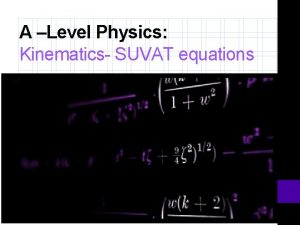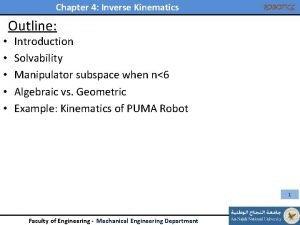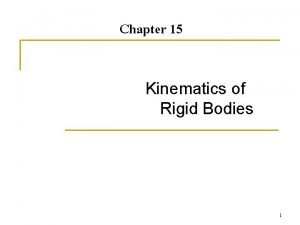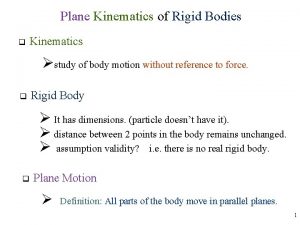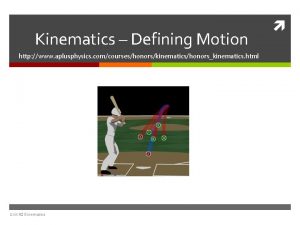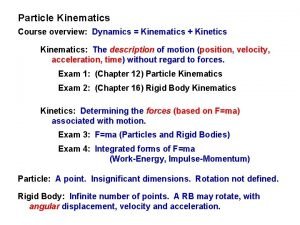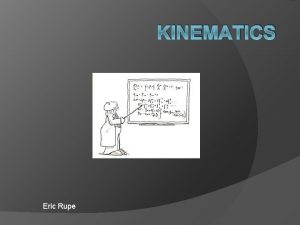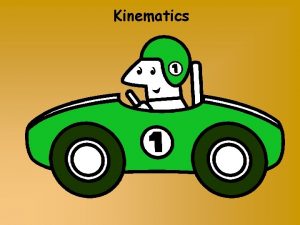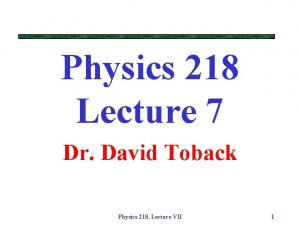Physics 218 Lecture 4 Kinematics in 2 3




























- Slides: 28

Physics 218 Lecture 4: Kinematics in 2 -3 D Alexei Safonov

Speeder A speeder passes you (a police officer) sitting by the side of the road and maintains their constant velocity V. You immediately start to move after the speeder from rest with constant acceleration a. • How much time does it take to ram the speeder? • How far do you have to travel to catch the speeder? • What is your final speed? Police Officer Speeder X

Free Fall • Free fall is a good example for one dimensional problems • Gravity: – Things accelerate towards earth with a constant acceleration – a=g=9. 8 m/s 2 towards the earth – We’ll come back to Gravity a lot!

Throw a Ball up You throw a ball upward into the air with initial velocity V 0. Calculate: a) The time it takes to reach its highest point (the top). b) Distance from your hand to the top c) Time to go from your hand come back to your hand d) Velocity when it reaches your hand e) Time from leaving your hand to reach some random height h.

You throw a baseball straight up in the air. Where is the acceleration due to gravity the greatest? A. As soon as the ball leaves your hand. B. At the balls highest level. C. Just before the ball falls back into your hand. D. It’s the same everywhere.

Leaning over the top of a building you throw one ball up and one ball down with the same speed. Which ball will have the greater velocity when they hit the ground? A. The velocities will be the same. B. The ball thrown up, because it as more distance to fall. C. The ball thrown down, because you give it a downward throw to start. D. It depends on the mass of the balls and height of the building.

Clicker Question ? 4 ft 1 ft 9 ft 16 ft At t = 0 a ball, initially at rest, starts to roll down a ramp with constant acceleration. Suppose it moves 1 foot between t = 0 sec and t = 1 sec. How far does it move between t = 1 sec and t = 2 sec? A) 1 foot B) 2 feet C) 3 feet D) 4 feet E) 6 feet

Vote again Checkpoint 2 At t = 0 a ball, initially at rest, starts to roll down a ramp with constant acceleration. Suppose it moves 1 foot between t = 0 sec and t = 1 sec. How far does it move between t = 1 sec and t = 2 sec? A) 1 foot B) 2 feet C) 3 feet D) 4 feet E) 6 feet

Clicker Question ? 4 ft 1 ft 9 ft 16 ft At t = 0 a ball, initially at rest, starts to roll down a ramp with constant acceleration. Suppose it moves 1 foot between t = 0 sec and t = 1 sec. How far does it move between t = 1 sec and t = 2 sec? A) 1 foot B) 2 feet C) 3 feet D) 4 feet E) 6 feet

Chapter 3 • Kinematics in Two or Three Dimensions • Projectile Motion • Uniform Circular Motion

Important Equations of Motion If the acceleration is constant Position, velocity and Acceleration are vectors.

Projectile Motion The horizontal and vertical equations of the motion behave independently Problem solving: The trick for all these problems is to break them up into the X and Y directions.

Constant Acceleration

Kinematics in 3 D

Projectile Motion & Frames of Reference

Checkpoint 1 A physics demo launches one marble horizontally while at the same instant dropping a second marble straight down. Which one hits the ground first? A) The launched marble hits first. B) The dropped marble hits first. C) They both hit at the same time. Lets check again

Checkpoint 1 A physics demo launches one marble horizontally while at the same instant dropping a second marble straight down. Which one hits the ground first? A) The launched marble hits first. B) The dropped marble hits first. C) They both hit at the same time.

Projectile Motion The horizontal and vertical equations of the motion behave independently Problem solving: The trick for all these problems is to break them up into the X and Y directions.

Projectile Motion Horizontal Vertical Boring

Monkey Troubles • You are a vet trying to shoot a tranquilizer dart into a monkey hanging from a branch in a distant tree. You know that the monkey is very nervous, and will let go of the branch and start to fall as soon as your gun goes off. In order to hit the monkey with the dart, where should you point the gun before shooting? • A) Right at the monkey • B) Below the monkey • C) Above the monkey

Shooting the Monkey… Dart x = vo t Monkey x = xo

Shooting the Monkey… Still works even if you shoot upwards! y = voy t - 1/2 g t 2 y = y o - 1/ 2 g t 2 Dart hits the monkey

Firing up in the air at an angle A ball is fired up in the air with velocity Vo and angle Qo. Ignore air friction. The acceleration due to gravity is g pointing down. What is the final velocity here?

• Checkpoint 2 A destroyer simultaneously fires two shells with the same initial speed at two different enemy ships. The shells follow the trajectories shown. Which ship gets hit first. Destroyer Enemy 1 A) Enemy 1 B) Enemy 2 C) They are both hit at the same time Enemy 2

Checkpoint 2 • …Which enemy ship gets hit first? • A) Enemy 1 B) Enemy 2 C) Same Destroyer Enemy 1 Enemy 2 A) they are traveling at the same speed, but the enemy one trajectory is shorter B) Both shots were accelerating towards the ground at the same rate, but the shot fired at Enemy 2 did not go as high and therefore took less time to fall back to the ground. C) we are given that two shells are fired at same speed. therefore, both ships should get hit at the same time.

Checkpoint 3 • A destroyer fires two shells with different initial speeds at two different enemy ships. The shells follow the trajectories shown. Which enemy ship gets hit first? Destroyer Enemy 1 A) Enemy 1 B) Enemy 2 C) They are both hit at the same time Enemy 2

Checkpoint 3 • …Which enemy ship gets hit first? • A) Enemy 1 B) Enemy 2 C) Same Destroyer Enemy 1 Enemy 2 A) Since the initial speed for the first shell is lower, Enemy Ship 1 will be hit first. B) The initial speed of the shell fired at ship 2 is greater, so ship 2 gets hit first. C) they both achieve the same height so they remain in the air the same amount of time

• How familiar are you with the concepts of relative motion and centripetal acceleration from your high school course. A) I already know this stuff B) It seems familiar, but I need a review C) We didn't learn this in high school Vast majority don’t feel very confident about this material.
 Aplusphysics kinematics-horizontal kinematics
Aplusphysics kinematics-horizontal kinematics 49 cfr part 218
49 cfr part 218 98 156 chia 4 63
98 156 chia 4 63 Ics multimedia
Ics multimedia Harpa cristã 218
Harpa cristã 218 Kinematics physics
Kinematics physics 4 suvat equations
4 suvat equations A level physics kinematics
A level physics kinematics Ib physics
Ib physics 01:640:244 lecture notes - lecture 15: plat, idah, farad
01:640:244 lecture notes - lecture 15: plat, idah, farad Physics 101 lecture 1
Physics 101 lecture 1 Physics 101 lecture notes pdf
Physics 101 lecture notes pdf Atmospheric physics lecture notes
Atmospheric physics lecture notes Classical mechanics
Classical mechanics Physical science notes pdf download
Physical science notes pdf download Physics 101 lecture notes pdf
Physics 101 lecture notes pdf University physics with modern physics fifteenth edition
University physics with modern physics fifteenth edition Ib physics ia ideas thermal physics
Ib physics ia ideas thermal physics Modern physics vs classical physics
Modern physics vs classical physics Poe practice test kinematics answers
Poe practice test kinematics answers Final velocity formula
Final velocity formula Inverse kinematics
Inverse kinematics Kinematics
Kinematics Kinematics and kinetics of rigid bodies
Kinematics and kinetics of rigid bodies Kinematics
Kinematics Jacobian singularity
Jacobian singularity Kinematics of a particle
Kinematics of a particle Plane kinematics of rigid bodies
Plane kinematics of rigid bodies Aplusphysics
Aplusphysics






